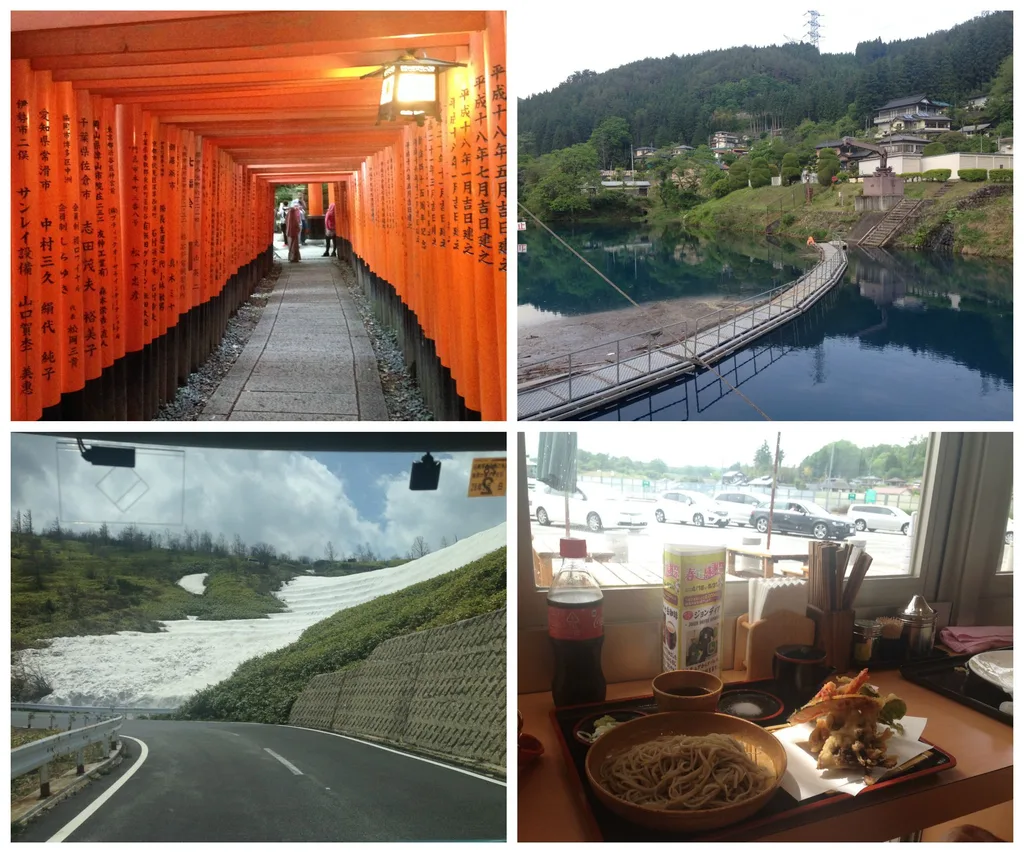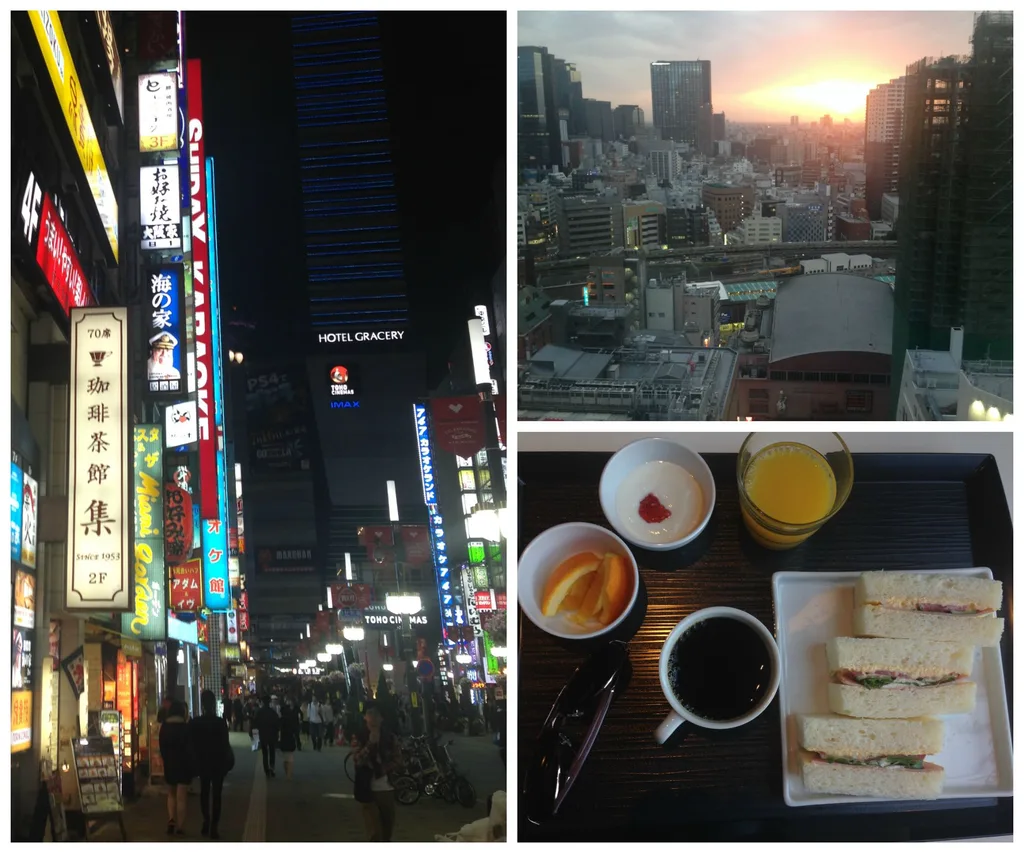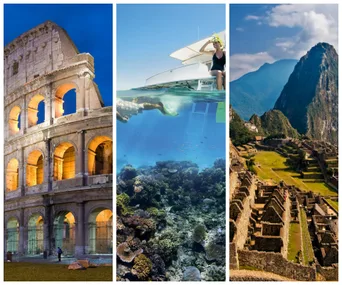Whenever I tell people I chose to drive through Japan in a hire car they are shocked.
“You must be crazy,” said one friend.
“Isn’t the traffic terrible? What about the street signs? Were you constantly lost?”
“Japan has the best rail network in the world. Who would even consider driving?”
To anyone who is doubtful, let me put my neck on the line here: Japan is a fantastic country to drive – as long as you have an English GPS!
Driving in another country takes a bit of confidence and a lot of planning.
Here I have outlined our guide to driving Japan in the spring.
First, the basics:
The roads in Japan are varied, from five-lane expressways to winding country roads set in beautiful lush green landscapes dotted with farm houses and traditional ryokans (see more below).
There is zero tolerance for alcohol, in fact you can’t have a single drink if you plan to drive.
Cars are right-hand drive (same as at home) and travel in the left lane.
There’s great infrastructure and local drivers are confident and courteous.
There are parking lots are everywhere, but they are expensive – some charge ¥4 for 10 minutes.
Most importantly, to avoid falling into the familiar arguments ensure you have an English GPS. These will be built into the dashboard of your car and the service staff at your dealership can program it so all you need to do is type the phone number of your next destination and the GPS will guide you.

(Clockwise from the top left) The famed Fushimi Inari Taisha, The roadside view through Gunma, A freshly cooked meal at a truck stop, The drive up the mountains to see Snow Monkeys of Gunma.
Upon arrival in Japan’s Narita airport we were met with many options to travel to our Shinjuku hotel, Hotel Gracery.
Firstly, the high speed train called the Narita Express or N’Ex. The train takes about 53 minutes and directly connects Narita International Airport with major urban areas in and around Tokyo including Tokyo, Shinagawa, Shibuya, Shinjuku, Ikebukuro and Yokohama.
The second option, a Limousine bus, stops at major hotels in the city. Adult fare for one way ticket is AUD$30 (¥3000).
Or, there’s taxi. Taxi’s are cheaper in Japan than back home and are a very enjoyable experience as most are old Toyota Crown’s complete with window curtains and fur seat covers. Though this ride could set you back about AUD$250 (¥2500).
Despite the nine hour flight from Sydney, Australia we decided to ignore all of these options and hire a car. Thus beginning our obsession with a self-drive tour of Japan.
Nippon is the car hire company with the largest fleet of cars equipped with English GPS.
Since the Olympics in 2014, road signs have English translation, but we still recommend the GPS.
A very helpful Nippon employee set us up with a Prius. We paid about AUD$140 (¥14,580) for a day hire to drop the car off in Shinjuku – but not before a detour to Yokohama where a group of Datsun fanatics were hosting a car meet.
After dropping our car at Nippon in Shinjuku we walked the two blocks to our accommodation – Hotel Gracery.
Located in the heart of Shinjuku and just a short walk from the railway, Gracery is a new 970 room hotel in Kabuchiko.
Rooms start from AUD$140 (¥14000) per night and we opted for the breakfast included option and treated ourselves to a meal each morning at one of the three restaurants within the building.
Bonsalute Kanuki is a Western Buffet with all the usual suspects including eggs, bacon and hashbrowns.
Bonjur is a cafe on the eighth floor offering a selection of sandwiches, yogurts, juice and coffee. Coffee is actually quite expensive in Japan so take advantage of any “breakfast included” deals to get a takeaway cuppa at the very least.
Thirdly, Earth’s Bounty Hakkaido on the ground floor offers traditional Japanese breakfast.
The food in Japan is fantastic. But be warned they love seafood, and seafood pastes. It’s a lot stronger than we are accustomed to at home.

(Clockwise from left) Hotel Gracey in Shinjuku, Tokyo; The view from our room; Breakfast at Bonjur.
MUST EAT IN TOKYO:
Ramen from Menya Musashi. Pick your bowl from the vending machine at the door and hand your ticket to the lively chefs. The noodles and chewy and thick. The broth divine and the pork soft and salty. A must.
Local Angus beef from Shonzui in Roppongi. This wine bar has a fantastic vibe. The bar is stacked with organic wines and there are cuts of angus beef on show. The waiter will bring across the meat plate and you can pick your steak. We had a mouth-watering Angus cooked to perfectiona nd served with potatoes and a salad. It was one of out most expensive meals in Japan, coming in at about AUD$200.
Japanese dumplings and beer at Gyoza Ro in Harajuku. Sit around the bar and watch in awe as the staff quickly serve up for dumplings boiled (sui) or pan-fried (yaki). Order the cabbage salad. It’s cheap and delicious with the whole meal coming in at about AUD$26 including beers.
Shiro Hige’s Cream Puff Factory in Setayaga makes delicious cream puffs in the shape of Studio Ghibli character, Totoro. We travelled by car and parked in a nearby parking lot, though it’s easily accessible by train.
What to do in Tokyo
Have a coffee at Starbucks overlooking Shibuya crossing.
See the view from Roppongi Tower and visit the modern art museum inside.
Spend hours lost in the ultimate craft store, Tokyo Hands.
.jpg?resize=1024%2C853)
(Clockwise from left) Beef and potatoes at Shonzui; the Ramen at Menya Musashi; The Totoro puff; Gyoza at Harajuku.
After a few nights in Tokyo we picked up our bright blue N-Box, that would pass as a golf cart in Australia, and travelled North to the Gunma Prefecture.
Gunma prefecture is 1.5 hours north west of Tokyo.
Famous for traditional Japanese guest houses and hot springs, the scenic driving is like being in a movie.
We travelled straight to Ikaho Toy, Doll and Car Museum (complete with a squirrel sanctuary) before taking the winding road to Shima Onsen Kashiwaya Ryokan – our traditional japanese guest house.
This beautiful Ryokan is set in the mountains. The traditional rooms have thatched flooring and the staff set up a futon for you before bedtime.
It is a stark contrast to the bright lights and fast pace of Tokyo and there is a private onsen.
Onsen basics:
Onsen is a hot spring bath that is private or communal.
You must wash before you enter the onsen and you must be completely starkers (no bathers or undies) even if it is a communal bath.

Shima Onsen Kashiwaya Ryokan.
After a good nights sleep we drove north through the winding mountains, some capped with the last snow from winter, to see the snow monkeys who bathe in the hot springs at Jigokudani Yaenkoen. Entry is AUD$5.
Next stop was Matsumoto. Famous for Japan’s oldest castle Matsumoto Castle though the thing I will remember most is the soba noodles.
We stumbled across Soba house Alps, a handmade soba noodle restaurant in the back streets of Matsumoto.
Owner Ben. Hiroshi Saikawa makes the noodles, which are like vermicelli but made from buckwheat.
We feasted on seafood tempura and sucked the noodles up in a delicious broth.
There is an English menu and the waiter was very patient with our poor Japanese.
Next we travelled to Mount Fuji to see the great mountain in all her glory.
En route we stopped at a truck stop (food pictured above). These are nothing like the McDonalds drive through and Caltex at home. Chefs cook hot meals to order and most are equipped with grocery stores, bake bars and clothing shops.
The toilets are clean and the staff at the petrol station will run over to the car and fill your tank, while an assistant washes down the windscreen.
Where to stay
Mt fuji View Hotel – look out your window and up at Mt Fuji.
Visit the Happy Days tin and nostalgia museum for a flashback to the tin toys of yesteryear.

Our blue golf cart!
Next we drove to Kyoto with a quick stopover in Toyota city, the business district of Japan, and home to the Toyota Museum where you can see robots build a car.
Kyoto is the old world Japan, we stayed in the amazing Ryokan Sumiya Kihoan in Kameoka about an hour from the centre of Kyoto.
The Ryokan is set into a lush mountain with one of the most spectacular outdoor private onsen’s – it was like being a mermaid, all rocks and moss.
Our room was about AUD$220 a night.
The hotel does regular bus trips into main rail line for those who don’t want to drive.
Eating in Kyoto
Prepare for the best Katsu Don of a lifetime at Katsugyuu Kyoto style beef wagyu.
What to do
Visit the Fushimi Inari Shrine.
Bike hire is popular though hard to push through loads of people.
You can drive through all the little lanes of Kyoto, but take care as people walk carefree expecting the car to move before they will!
Top Tips
Pocket Wifi: You can order this in advance. It costs about AUD$100 and is a small black device that looks like a bar of soap you can slip in your pocket and have wifi at all times. This is a huge saver on international phone data.
Language: The people of Japan are so lovely they will try really hard to help you understand if you don’t know the language. Try to learn the basic niceties.
Climate: In spring it is t-shirt weather most days, though take a coat for night as the temperature drops.
Hotels.com Rewards has an industry-leading loyalty program where members earn a free night after every 10 nights stayed at nearly 200,000 hotels across the world, with no blackout dates.
.jpg?fit=900%2C750)


